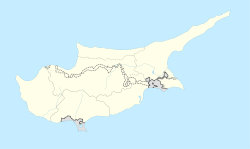Chytri
Χύτροι | |
 Map showing the ancient city Kingdoms of Cyprus | |
| Location | Cyprus |
|---|---|
| Region | Nicosia District |
| Coordinates | 35°15′07″N 33°29′41″E / 35.251979°N 33.494769°E |
Chytri (or Khytri, Greek: Χύτροι) was one of the ten city-kingdoms of Cyprus in antiquity. It was beautifully located in the centre of the island, in the territory of Chytraea, west of Mesaoria. Today the modern town of Kythrea (Kyrka) has preserved the ancient name.
Ancient history
After 1200 B.C. and after the Trojan war many Greek immigrants led by Chytros, grandson of the Athenian Akamantas, hero of the Attican tribe of the same name, settled in Cyprus. Kythrea is situated near the ancient kingdom of Chytroi which was founded by Chytros. There has been found here a necropolis. In the time of the Assyrian king Assurbanipal, Pilagura was King of Kitrusi, one of the ten kingdoms on the island. Numerous inscriptions have been found in the Cypriot dialect, some in ordinary Greek. Chytri was noted for the worship of Apollo, Artemis and Aphrodite Paphia. Later forms of the name are Cythraia, Cythereia, Cythroi, Chytrides; according to the late Greek work of Sakellarios (Kypriaka, 2nd ed., 202-205) Kyrka should be Cythera or Cythereia; he identifies Chytri with Palo-Kythro, a village with ruins two hours south of Kyrka. However, the historical texts mention only one town.
Middle Ages
Chytri was at an early date an episcopal see. Lequien's list of the bishops of the see (II, 1069) is very incomplete, only eight being recorded: the first is St. Pappus, who suffered martyrdom under Licinius, Maximinus or Constantius Chlorus; the most famous is St. Demetrian, 885-912 (?).
The Greek, i.e. Orthodox, see of similar title was suppressed in 1222 by Cardinal Pelagius, the papal legate,[1] while the islands was a Latin crusader kingdom.
References
- ^
 Herbermann, Charles, ed. (1913). "Chytri". Catholic Encyclopedia. New York: Robert Appleton Company.
Herbermann, Charles, ed. (1913). "Chytri". Catholic Encyclopedia. New York: Robert Appleton Company.

